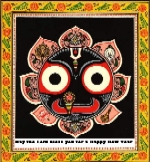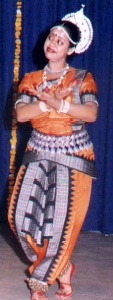|
- The dynamism of Divine Love and Human Passion
Odissi is the most ancient of all classical Indian
dance forms, which was originated from the eastern state of Orissa in India.
It is a graceful style of classical dance that is inspired thematically by
the literature, art and spiritual movements of the Vaishnava sect of
Hinduism, and in technique, by the ancient Hindu temple sculptures of Orissa.
Originally Odissi was performed as mahari or devadasi dance,
in front of Lord Jagannath in the temples of Orissa, which can be traced to
10th century A.D. The dances of maharis in the temples were basically
ritualistic. The Nartikis performed in the royal court and for the
general public at the traditional festivals like Vasantotsav.
With social and political changes in Indian society, the Mahari
tradition started declining and a new class of dancers was created to revive
the Odissi dance tradition starting in the 17th century. This class
consisted of young boys or Gotipuas who danced in female costumes for
the general masses to convey the spiritual stories.
After India’s independence from colonial rule in 1947, much of Odissi
dance was revived by a number of individuals known as Gurus. The
legendary Guru Kelucharan Mohapatra, Guru Pankaj Charan Das, Guru Deba
Prasad Das, Guru Mayadhara Rout etc., scholars and performers came together
for research based on the traditions and ancient texts such as the Natya
Shastra and Abhinaya Darpanam, to create this style in
its present form.
The classical dance form of Odissi is a dance of love and passion,
tender and intense. Highly stylized in nature, it utilizes both
powerful, energetic footwork (Tandava), and graceful feminine
postures and movements (Lasya). The most important elements in the
Odissi dance are the Bhangis (stylised poses) and Karanas
(Yoga based body positions). It has an intensely emotional and lyrical
structure which is based on the popular devotion to Lord Krishna.

Traditionally Odissi dance is performed by four parts, Mangalacharana,
Pallavi, Avinaya and Mokshya.
Mangalacharana - a dance of invocation. It consists of a verse in
praise of a divinity like Brahma, the God of creation, Saraswati, the
Goddess of art, or Ganesha, the God of knowledge, followed by a sequence of
steps, emphasising the Odissi idiom.
Pallavi - means to elaborate. It consists of pure dance movements and
steps with a chosen time cycle and set to a musical raga (melody). In this
part, dancers shows various body postures similar to temple sculptures.
Avinaya – the emotions and the expression. In Avinaya, the verses of
the Sanskrit play Geet Govinda of poet Jayadeva written in the 12th century
A.D., are used by dancers to depict the love and devotion to God. Songs of
other Oriya poets are also danced with subtle expressions and emotions.
Mokshya – the concluding part. In mokshay, a dancer employs various
dance units to create a lasting visual effect on spectators.
Back to top |
